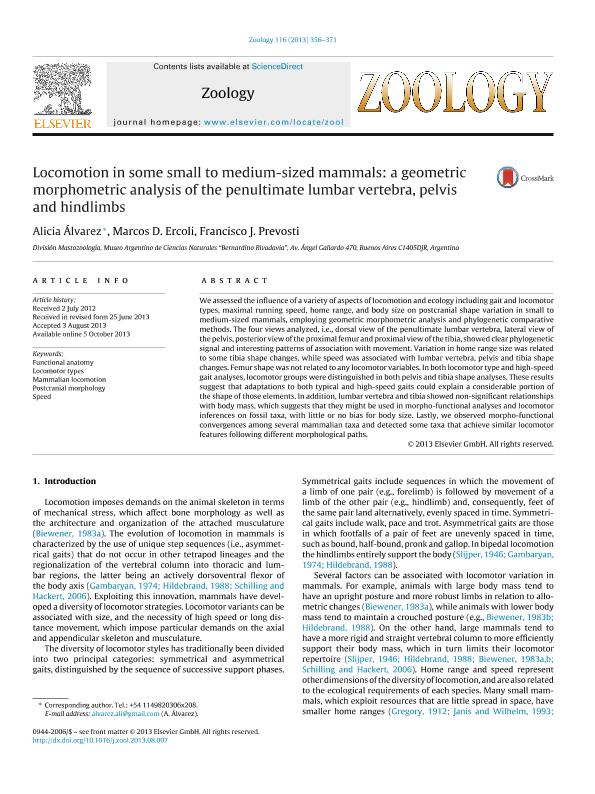Mostrar el registro sencillo del ítem
dc.contributor.author
Alvarez, Alicia

dc.contributor.author
Ercoli, Marcos Darío

dc.contributor.author
Prevosti, Francisco Juan

dc.date.available
2016-12-14T15:18:20Z
dc.date.issued
2013-10-05
dc.identifier.citation
Alvarez, Alicia; Ercoli, Marcos Darío; Prevosti, Francisco Juan; Locomotion in some small to medium-sized mammals: a geometric morphometric analysis of the penultimate lumbar vertebra, pelvis and hindlimbs; Elsevier Gmbh; Zoology; 116; 6; 5-10-2013; 356-371
dc.identifier.issn
0944-2006
dc.identifier.uri
http://hdl.handle.net/11336/9340
dc.description.abstract
We assessed the influence of a variety of aspects of locomotion and ecology including gait and locomotor types, maximal running speed, home range, and body size on postcranial shape variation in small to medium-sized mammals, employing geometric morphometric analysis and phylogenetic comparative methods. The four views analyzed, i.e., dorsal view of the penultimate lumbar vertebra, lateral view of the pelvis, posterior view of the proximal femur and proximal view of the tibia, showed clear phylogenetic signal and interesting patterns of association with movement. Variation in home range size was related to some tibia shape changes, while speed was associated with lumbar vertebra, pelvis and tibia shape changes. Femur shape was not related to any locomotor variables. In both locomotor type and high-speed gait analyses, locomotor groups were distinguished in both pelvis and tibia shape analyses. These results suggest that adaptations to both typical and high-speed gaits could explain a considerable portion of the shape of those elements. In addition, lumbar vertebra and tibia showed non-significant relationships with body mass, which suggests that they might be used in morpho-functional analyses and locomotor inferences on fossil taxa, with little or no bias for body size. Lastly, we observed morpho-functional convergences among several mammalian taxa and detected some taxa that achieve similar locomotor features following different morphological paths
dc.format
application/pdf
dc.language.iso
eng
dc.publisher
Elsevier Gmbh

dc.rights
info:eu-repo/semantics/openAccess
dc.rights.uri
https://creativecommons.org/licenses/by-nc-sa/2.5/ar/
dc.subject
Biomecanica
dc.subject
Mammalia
dc.subject
Functional Anatomy
dc.subject
Locomotor Types
dc.subject
Postcranial Morphology
dc.subject
Speed
dc.subject.classification
Bioquímica y Biología Molecular

dc.subject.classification
Ciencias Biológicas

dc.subject.classification
CIENCIAS NATURALES Y EXACTAS

dc.title
Locomotion in some small to medium-sized mammals: a geometric morphometric analysis of the penultimate lumbar vertebra, pelvis and hindlimbs
dc.type
info:eu-repo/semantics/article
dc.type
info:ar-repo/semantics/artículo
dc.type
info:eu-repo/semantics/publishedVersion
dc.date.updated
2016-11-22T21:10:02Z
dc.journal.volume
116
dc.journal.number
6
dc.journal.pagination
356-371
dc.journal.pais
Alemania

dc.journal.ciudad
Berlin
dc.description.fil
Fil: Alvarez, Alicia. Consejo Nacional de Investigaciones Científicas y Técnicas. Oficina de Coordinación Administrativa Parque Centenario. Museo Argentino de Ciencias Naturales; Argentina
dc.description.fil
Fil: Ercoli, Marcos Darío. Consejo Nacional de Investigaciones Científicas y Técnicas. Oficina de Coordinación Administrativa Parque Centenario. Museo Argentino de Ciencias Naturales; Argentina
dc.description.fil
Fil: Prevosti, Francisco Juan. Consejo Nacional de Investigaciones Científicas y Técnicas. Oficina de Coordinación Administrativa Parque Centenario. Museo Argentino de Ciencias Naturales; Argentina
dc.journal.title
Zoology

dc.relation.alternativeid
info:eu-repo/semantics/altIdentifier/doi/http://dx.doi.org/10.1016/j.zool.2013.08.007
dc.relation.alternativeid
info:eu-repo/semantics/altIdentifier/url/http://www.sciencedirect.com/science/article/pii/S0944200613000810
Archivos asociados
